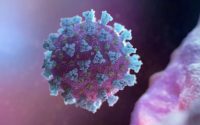Warning signs for tick-borne meat allergy
A disease so unusual that many doctors can’t diagnose it has emerged as a serious threat — and Long Island’s Suffolk County is the nation’s epicenter.
Alpha-gal syndrome, sometimes called AGS, is spread by bites from the lone star tick. It causes people to have a violent reaction to red meat and dairy and about 4% of US cases are found in Suffolk County, according to the Centers for Disease Control and Prevention, making eastern Long Island the country’s hot spot.
“We have to sound the alarm out here,” Kathy Agoglia, who lives in Laurel, told the Suffolk Times. “It’s here, it’s serious, and the numbers are very, very concerning.”
Agoglia, a dentist, has personal experience with AGS: Last month, after having meat for dinner, she began to develop symptoms.
“An hour or so later I broke out in an itchy rash,” she said. “I was suspicious, as I know a little bit about ticks. And a month or so earlier I had been bitten by a lone star tick.”
Her doctor in Mattituck confirmed her suspicions: “I got a blood test, and it was positive,” Agoglia said.
Doctors are unaware of alpha-gal syndrome
Because alpha-gal syndrome isn’t well known, it often goes undiagnosed, so there may be many more cases in the population than the 450,000 people the CDC estimates have the disorder.
And many doctors know next to nothing about AGS: A recent CDC survey of 1,500 health care providers revealed that “42% were not aware of AGS, and another 35% were not confident in their ability to diagnose or manage AGS patients.”

The CDC report adds: “Limited … knowledge about AGS is concerning, especially because the number of suspected cases is increasing, and the range of the tick primarily associated with this condition is expected to expand.”
What is alpha-gal syndrome?
Alpha-gal syndrome is caused by a sugar molecule known as alpha-gal, which is carried in the saliva of the lone star tick.
In some people, a bite from the tick triggers an immune system reaction to meat from mammals, such as beef, pork, venison, rabbit or lamb, according to the Mayo Clinic.
It can also cause a reaction to other foods that come from mammals, including dairy products and gelatins. However, seafood, chicken and other poultry don’t cause a reaction and are safe for people with AGS.
Symptoms of alpha-gal syndrome may include hives or itchy, scaly skin; swelling of the lips, face, tongue and throat; wheezing or shortness of breath; and stomach pain, diarrhea or vomiting.

In cases of a severe reaction, anaphylaxis can result, causing trouble breathing; rapid or weak pulse; dizziness; and drooling and not being able to swallow.
Where are lone star ticks found?
The lone star tick is found throughout the eastern US and is particularly prevalent in Arkansas, Kentucky, Virginia and Missouri. Populations of the tick are growing, however, and public health officials believe it could spread further.
There’s no cure for AGS, and people with the condition have to avoid all mammal-based foods. Some people may also have to carry epinephrine — an EpiPen — in case of a reaction.
In some people, the condition eases over time, and they can safely resume eating red meat and dairy. But another tick bite can cause AGS to flare up again.
Suffolk County has emerged as a hot spot because the region’s deer population has exploded in recent years.
“Anywhere … deer are in abundance, you will encounter the lone star tick,” Dr. Erin McGintee, a member of the Suffolk County Board of Health, told the Suffolk Times.
“The deer are a big problem,” McGintee said. “They don’t have any predators and they are a breeding ground for ticks.”
McGintee, who was raised in East Hampton, also noted, “We had ticks when I was a kid, but we didn’t have this tick. Now you find more lone star ticks. It has outcompeted the other ticks and is now the dominant one.
“On a typical day in my practice, I see at least three or four patients with a positive [AGS] test,” she added. “It’s a big, big problem out here.”


